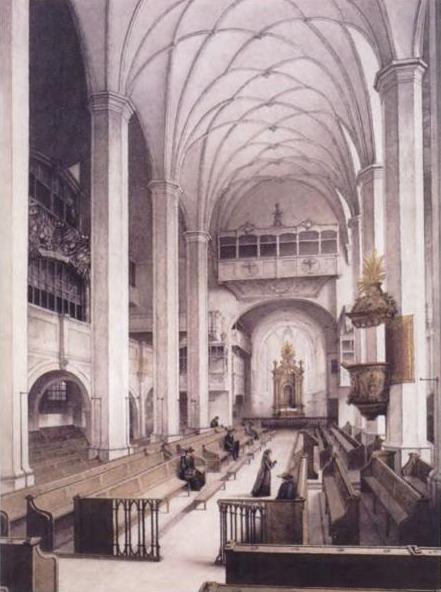Movements 6 | Cantata text anonymous | |
 | ||
Ach Herr, mich armen Sünder (Ah Lord, poor sinner that I am), BWV 135, is a church cantata by Johann Sebastian Bach. He composed it in Leipzig for the third Sunday after Trinity and first performed it on 25 June 1724. It is the fourth chorale cantata from his second annual cycle, of chorale cantatas, based on the hymn by Cyriakus Schneegass.
Contents
History and words
Bach composed the cantata in Leipzig for the Third Sunday after Trinity as the fourth cantata of his second annual cycle of chorale cantatas and first performed it on 25 June 1724, after Christ unser Herr zum Jordan kam, BWV 7, on St. John's Day.
The prescribed readings for the Sunday were from the First Epistle of Peter, "Cast thy burden upon the Lord" (1 Peter 5:6–11), and from the Gospel of Luke, the parable of the Lost Sheep and the parable of the Lost Coin (Luke 15:1–10). The cantata is based entirely on the chorale "Ach Herr, mich armen Sünder" (1597) by Cyriakus Schneegass, a paraphrase on Psalm 6 in six stanzas. The connection to the readings is rather marginal, the Lord's comforting (movement 3) and destruction of the enemies (5) refer to the epistle, the joy about a repenting sinner, the theme of the chorale, to the gospel. The unknown poet kept the first and last stanza unchanged. He paraphrased the other four stanzas to four movements, alternating recitatives and arias.
Scoring and structure
The cantata in six movements is scored for three vocal soloists (alto, tenor and bass), a four-part choir, cornett, trombone, two oboes, two violins, viola, and basso continuo.
The cantata is in six movements:
- Chorus: Ach Herr, mich armen Sünder
- Recitative (tenor): Ach heile mich, du Arzt der Seelen
- Aria (tenor): Tröste mir, Jesu, meine Gemüte
- Recitative (alto): Ich bin von Seufzen müde
- Aria (bass): Weicht, all ihr Übeltäter
- Chorale: Ehr sei ins Himmels Throne
Music
The opening chorus is a chorale fantasia as in the previous chorale cantatas. Bach had started the first one of his second cycle with the cantus firmus of the chorale tune in the soprano, in this fourth work the bass has the honour. According to Christoph Wolff, the first four cantatas of the cycle form a group, distinctively different in their chorale fantasias. After a French Overture (O Ewigkeit, du Donnerwort, BWV 20), a motet (Ach Gott, vom Himmel sieh darein, BWV 2) and an Italian concerto (Christ unser Herr zum Jordan kam, BWV 7), the movement is an "extraordinary filigree of vocal and instrumental counterpoint" of the chorale melody. John Eliot Gardiner observes: "Together they make a fascinating and contrasted portfolio of choral fantasia openings." All parts, even the instruments, take part in the polyphonic setting of the tune. Bach used the melody, originally a love song, later for the first chorale of his Christmas Oratorio, "Wie soll ich dich empfangen", and several times in his St Matthew Passion, most prominently "O Haupt voll Blut und Wunden". All eight lines of the text are first treated instrumentally, then vocally. The instrumental anticipation is a trio without continuo of oboe I and II against the strings, which play in unison the cantus firmus. In stark contrast to this high texture, the four-part vocal setting is dominated by the cantus firmus in the bass, reinforced by the trombone and the continuo. The strings play colla parte with the other voices. On the words "daß ich mag ewig leben" (that I may live forever) the cantus firmus is broadened to three times as slow.
In the tenor recitative, "rushes of notes" illustrate the images of the repentant sinner's "tears, which, like rapid rivers, roll down my cheeks. My soul is anxious and fearful with terror". It is concluded by an original line from the chorale, "Ah, Lord, why so long?". In the tenor aria, accompanied by the two oboes, the "collapse in death" is pictured by falling sevenths, "silent in death" by long silences. The alto recitative opens with an original line of the chorale, "I am weary of sobbing", expressed in a variation of the first line of the tune. The bass aria is a vigorous call, "Hence, all you evildoers". The strings play a forceful two-bar phrase, repeated twice at lower pitches, at which point it soars upwards and becomes increasingly dispersive in nature. In Bach's Obituary, written by Carl Philipp Emanuel Bach and Agricola and published in 1754 mention is made of his distinctive melodies which are described as "strange" and "like no others". This is a good example; scrupulously shaped and crafted, ranging over nearly three octaves and carried forward through jagged shapes whilst radiating an unprecedented vigour and all the time reflecting the imagery of the text. The cantata closes with a four-part chorale, the soprano reinforced by the cornett.
Recordings
The listing is taken from the selection on the Bach-Cantatas website.
